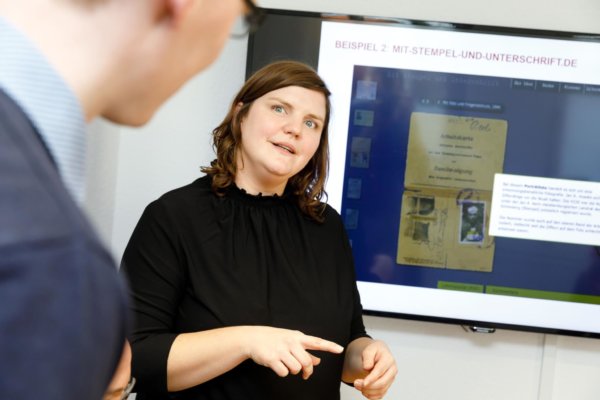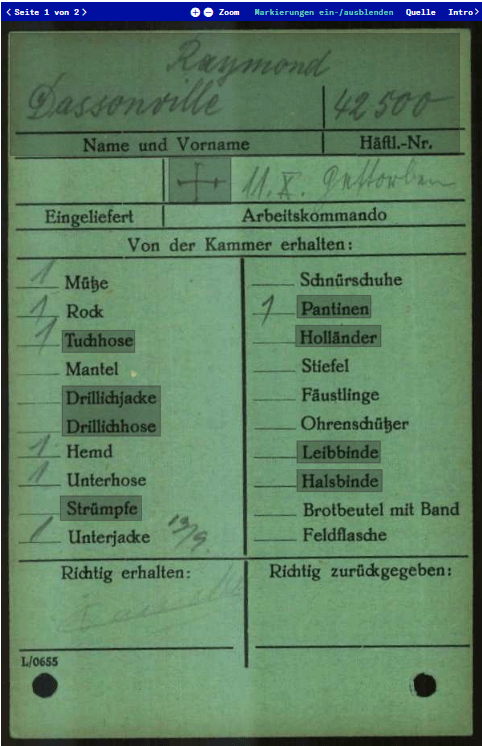The e-Guide.
Helps, explains, knows the ins and outs.

What do the abbreviations stand for? Where were the documents created, and for what purpose? The files in the Arolsen Archives are not self-explanatory. They need explanation to be able to tell their stories about the victims and the survivors of Nazi persecution. That’s all the more important in view of the fact that they’re often the last surviving witnesses to the murder of human beings.


What documents does the e-Guide explain?
The e-Guide concentrates on examples of individual documents, e.g. index cards and forms pertaining to individual Nazi victims and Survivors. These documents require more explanation than, for instance, concentration camp lists.
“It’s amazing what a single letter can tell you.”
Christiane Weber, a research associate in the Arolsen Archives’ Department of Research and Education, has been working on implementing the e-Guide project since May 2017. To that end, she investigated the historical background of documents from the concentration camps and the Displaced Persons camps. In the interview she talks about her fascinating research and the advantages offered by the Arolsen Archives e-Guide.
You worked with a team to research the documents and their contexts for the Arolsen Archives. That sounds interesting!
Well yes, the work on the e-Guide really was a bit like detective work. In each case, we had to find the exact persons or historical documents that would provide an answer or help us along. It’s hard to imagine what it feels like when, for example, after days, weeks, even months of searching, you suddenly figure out what a G or a Z on a clothing depot card means.

Christiane Weber explaining the e-Guide

What do they mean? And how does that help the e-Guide users?
The simple letters G and Z stand for “Gefangenen-” and “Zivilkleidung”—prisoner and civilian clothing. That means that, for instance, a descendant of a concentration camp inmate can decipher what clothing his or her father or grandmother had to wear. On the one hand, that’s very personal information. But it also allows you to draw more general conclusions. In our workshops, for example, the two letters show school pupils how the system of clothing distribution changed over the years. The longer the war dragged on, the scarcer were the striped prisoners’ uniforms we now usually associate with concentration camp inmates. Instead, more and more inmates had to wear the civilian clothing of fellow inmates who had died, or of Jews who had been killed. It’s amazing what a single letter can tell you about a person’s fate—and that’s exactly what the e-Guide descriptions are all about.
Are non-historians also aware of the significance of these supposedly trivial details?
Oh, yes, absolutely. In all the Arolsen Archives’ departments, we receive inquiries that point to an awareness of, and interest in, the fact that the cards can tell stories about people. And apart from these supposedly trivial details, there are also the larger categories the Arolsen Archives e-Guide user can actively learn about.
You mean historical contextualization?
Exactly. For the first time, we’ve managed to combine knowledge that was long scattered among the minds and desk drawers of many different people. And we welcome every further contribution with open arms because we want to expand the e-Guide. Our decision to use a digital presentation form was very deliberate because it offers countless means of integrating new or changing knowledge.
One last question: Who is the Arolsen Archives e-Guide for?
That’s easy! The e-Guide is for anyone interested in documents pertaining to the victims of Nazi persecution and what they mean. We made it a point to incorporate as much background knowledge as possible so that everyone can benefit from the e-Guide: people visiting the archive here in Arolsen or at our partner organizations, school pupils who see or work with the documents in class or during visits to concentration camp memorials, and last but not least the relatives of victims who inquire with the Arolsen Archives about the fates of their family members. No one is excluded, and we want everyone to profit from the new knowledge contained in the e-Guide.
FAQ
Currently the e-Guide offers explanations of documents pertaining to individual concentration camp inmates and documents drawn up by the Allies on the care and maintenance of survivors (DPs) after the war, for example prisoner registration cards, sick bay cards or post control cards. Descriptions of records on forced labor will follow in 2020.
A mobile version of the e-Guide is available. The layout was adapted to that purpose, making it easy to learn the most important facts about the Arolsen Archives’ key document types interactively on your smartphone or tablet. And of course everything is well illustrated and easily understandable, just like in the PC version.
No, that’s not possible. But each example document is explained in such simple and easily understandable terms that it serves as a key to all of the documents of that type. With the aid of five fundamental questions about each document type, the e-Guide describes who used the respective card or form, when, why, how and for what purpose. In each case, there is also an illustration of an example document whose individual fields, abbreviations and symbols you can click for explanations. Links moreover provide interesting and useful facts on the historical background.
To reach as broad a public as possible, the e-Guide is available in German and English.

